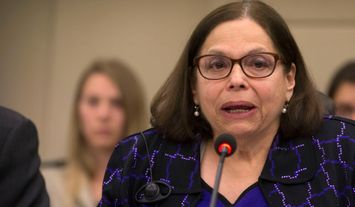Photo by MARK SCHIEFELBEIN/AFP Via Getty Images
Marie-Rose Sheinerman
February 26, 2021
Forward
In 1970, Judith “Judy” Heumann became the first wheelchair user to teach in a New York City public school. Seven years later, she led a 28-day sit-in that resulted in the signing of Section 504 of the Rehabilitation Act — the first federal civil rights law protecting those with disabilities. Since then, Heumann, 73, has served in both the Clinton and Obama administrations and become an international leader in disability rights work.
In February 2020, Heumann published her book Being Heumann: An Unrepentant Memoir of a Disability Rights Activist. On March 2, she will be speaking publicly at a virtual event hosted by Hillel and moderated by Naomi Hess, a junior at Princeton who is passionate about raising awareness of disability issues in Jewish spaces.
As Jewish Disability Awareness and Inclusion Month comes to a close, The Forward spoke with Heumann about the pandemic’s impact on disability rights, her hopes for the Biden administration and how Jewish communities can better elevate the voices of their disabled members. The conversation below has been lightly edited for clarity and length.
Synagogues and most Jewish community centers have been closed during the pandemic. I previously wrote about how Zoom may be opening doors to Jewish prayer spaces for some who don’t normally have access. After the pandemic is over, what lessons of accessibility should Jewish spaces take for the future?
I think we shouldn’t be jumping to conclusions. I think it’s very obvious that one of the important things about this is being able to attend services at synagogues anywhere in the country if they’re doing things virtually. That isn’t even a disability-related issue.
The synagogue I go to in DC – Adas Israel – for many years, they have had the ability to call in, not video… That was something that I used from time to time when it was really cold outside, maybe I would call in. I think being able to keep going virtually could be very important for somebody who is sick, they don’t drive anymore, whatever it might be. But I would definitely not want things to mainly be virtual. I like going to synagogue, because it’s a place for me to be and kind of reflect and meditate.
I think what’s been great about virtual is I think people are really looking — or need to be looking — at what we thought could or couldn’t happen previously, but not go to one extreme or the other. While this has been very beneficial in some cases, virtual has also been difficult for people with certain types of disabilities — low vision and people who are deaf or hard of hearing — [because] there is no captioning. The universe has expanded in a way that we didn’t anticipate previously, in a way that’s forced us to look at things that we previously didn’t.
What do you want to see the Jewish community be doing better for disability awareness and inclusion — beyond pandemic-specific issues?
I think I want it to no longer be called “awareness and inclusion.” We don’t say that for the LGBTQ community or the POC [People of Color] community… For those communities, I think we’ve recognized that we’re having to deal with issues of discrimination and inclusion, learning about what the barriers are, what our feelings are, how we treat people. I think that’s very important.
What I think is really interesting is how younger Jewish disabled and non disabled people are really thinking about these issues in a much more proactive way…
What do I want? I want the younger community really to have more influence. Typically, in synagogues and other religious groups, older people play more of a role. I think it’s really important for younger people to be looking at the issues of Black Lives Matter, broader communities, segregation — and to speak out about what they want and make it a part of what we’re doing.
That’s a good transition to something else I wanted to ask. There’s a few big movements right now, towards women’s rights and racial justice, and questions of intersectionality come up in all of them. I’m curious how you see those movements being inclusive, or not inclusive, of people with disabilities?
I think it’s fair to say that we’re all learning from each other. Disability, I feel, is really one of the last groups… When looking at intersectionality, I still don’t hear other movements talk about disability regularly. I think it’s a combination of separation, isolation from each other.
I’m learning that disabled individuals are participating in their synagogues. But when you really get to a more meaningful discussion, they still don’t feel a part of the community because of things that people say to them, or don’t say to them, or include or don’t include. I think it’s really, at the most ground level, trying to get people to talk about issues.
Source: forward.com/news/464916/a-conversation-with-jewish-disability-rights-advocate-judy-heumann/




